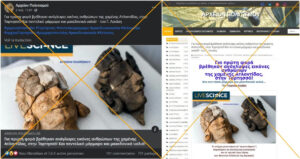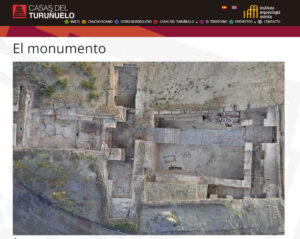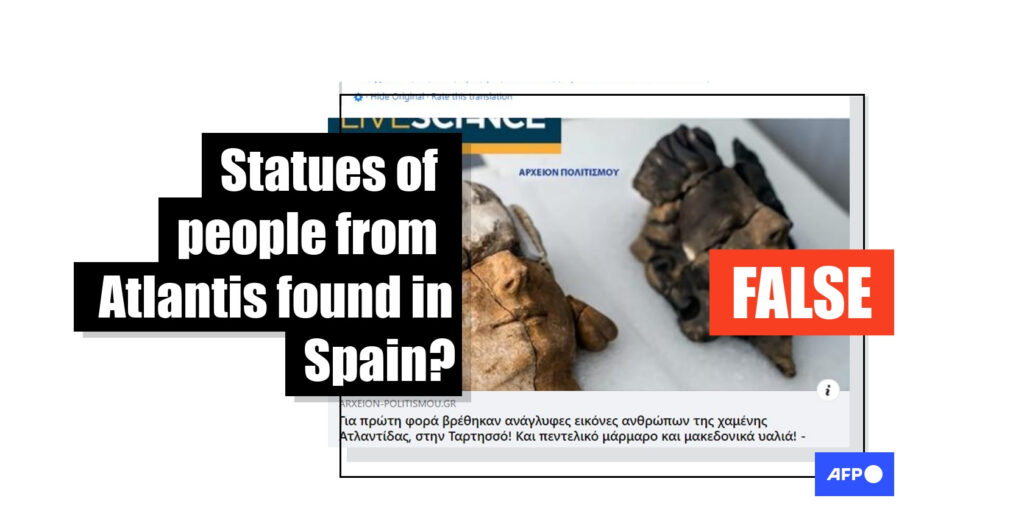The recent discovery of 5th-century BC reliefs depicting human faces at an archaeological site in southwest Spain marked a breakthrough in historians’ understanding of the ancient Iberian civilization of Tartessos. But a Greek article shared hundreds of times online has warped the discovery into myth, claiming that these sculptures are “the first embossed images of humans from the lost Atlantis” and that “the ancient city of Tartessos was ancient Greek”. This is not historically accurate, according to experts who told AFP the artefacts are not linked to Atlantis, a fictional civilization, and that Tartessian culture was not Hellenic as claimed.
The title of the misleading online article, published on May 2, 2023, reads: “For the first time, relief images of the inhabitants of the lost Atlantis have been found in Tartessos!”
The article has been shared more than 800 times on social media platforms such as Facebook (here and here) and Twitter.

 Screenshots of the misleading Facebook post (left) and the misleading article online (right). Images captured: 09/05/2023
Screenshots of the misleading Facebook post (left) and the misleading article online (right). Images captured: 09/05/2023The article makes reference to a theory that links the fictional island of Atlantis to Tartessos, which the article describes as a “Greek city”. This connection was also raised in an article published in the Daily Mail of April 21, 2023 about the recently-discovered artefacts. The headline of the British tabloid reads: “Is this the first look at a lost civilisation linked to Atlantis?”
But experts, including the director of the excavation mission in Spain, told AFP that although Tartessian culture has previously been associated with the myth of Atlantis, there is no credible connection between the two. The newly discovered statues are not ‘Atlantean’ and Tartessos was not a Hellenic culture as claimed. The latest excavation is significant because it contradicts the previous theory that the Tartessians did not produce representations of humans.
Faces change view of Tartessos
The fragments of the statues depicting humans were unearthed at an archaeological site called Casas del Turuñuelo 320km southwest of Madrid, researchers announced in April 2023. They are the first representations of humans from Tartessos to be found by archaeologists, according to the statement (link archived here) from Spain’s Superior Council of Scientific Research (CSIC).
“This extraordinary finding represents a profound paradigm shift in the interpretation of Tartessos, traditionally considered an aniconic culture for representing divinity through animal or plant motifs, or through sacred stones,” reads the press release.
The Tartessian civilization flourished from the 9th to the 6th centuries BC in the southwest of present-day Spain. Ancient Greek authors like Herodotus referenced Tartessos in their writings, describing it as rich in metals and minerals and engaged in trade with the Greeks and Phoenicians.For many years, a lack of conclusive archaeological evidence meant that the ancient civilization was shrouded in mystery. But recent discoveries at dig-sites in Spain are helping build a more detailed understanding of Tartessos and its inhabitants.
Mixing fact and fiction
The archaeological site of Casas del Turuñuelo, where the statue fragments were found, consists of a large, remarkably well-preserved building. Images are available here .

 Screenshot of the website of the Spanish research council’s archaeological project studying Tartessos, with a photo of the Tartessian building excavated in the Casas del Turuñuelo site, where the reliefs of human faces were found
Screenshot of the website of the Spanish research council’s archaeological project studying Tartessos, with a photo of the Tartessian building excavated in the Casas del Turuñuelo site, where the reliefs of human faces were foundTo investigate the claims in the Greek article, we first referenced the Spanish research team’s press release. It makes no mention of Atlantis or of the statues showing “representations of people from Atlantis”.
The head of the excavation team and another academic expert on Tartessos confirmed to AFP that this was a misrepresentation of the archaeological finding.
In an email to AFP on May 9, 2023, Carolina Lopez-Ruiz, a professor of the history of religions, comparative mythology and the ancient Mediterranean at the University of Chicago, and Sebastián Celestino Pérez, who led the excavation team at the archaeological site of Casas del Turunuelo, explained that any links made between the Tartessian civilization and the myth of Atlantis are not credible.
“The story of Atlantis does not portray a historical state or people, and it was not meant to be read historically by Plato”, explained Lopez-Ruiz.
In his telling of the legend of Atlantis, ancient Greek philosopher Plato described an island “beyond the pillars of Hercules” — known today as the Strait of Gibraltar — that was eventually subsumed under the Atlantic Ocean. The fictional story has continued to capture the public imagination ever since.
Lopez-Ruiz, who has written a paper exploring the identification of Atlantis with Tartessos, explained that “Tartessos has been associated with Atlantis within circles of pseudo-archaeology (along with other candidates for its ‘location’), mainly because Plato’s story situates the fictitious island/continent in the far west, outside the Straits of Gibraltar (roughly the area of Tartessos, which was not an island, however, let alone a continent)”.
This association also stems from the fact that Plato’s “story makes this kingdom extremely rich in metals, which is a quality associated by ancient sources and archaeologically documented for Tartessos”.
She added: “Whether Plato’s imaginary place was partly inspired by far-off places such as Tartessos (hard to demonstrate) or not, this does not mean we can equate Tartessos (the actual culture) and Atlantis (a mythological entity)”.
Tartessos was not Hellenic
Although Tartessos was mentioned by ancient Greek writers such as Herodotus (archived here), it was not a city of ancient Greek culture, according to the academics and recent archaeological evidence. Tartessian people had contacts with Greeks and Phoenicians, which led to some “some cultural influence”, but they were not Hellenic “anymore than the Celts or other western European groups”, wrote Lopez-Ruiz.
“We know their language was not Greek, not even Indo-European,” she added.
Sebastian Celestino Pérez, who led the excavation team, added that the newly-discovered statue fragments reveal insights about the cultural exchange that took place in Tartessos at the time.
“The statues, probably belonging to at least two women and a warrior, represent the assimilation of the Mediterranean artistic canons of the time by Tartessus, as well as relating a probably heroic scene which suggests the existence of a pantheon or mythology specific to Tartessus,” he wrote to AFP.
AFP has verified other claims about archaeological artifacts here.





